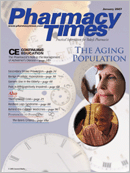Publication
Article
Pharmacy Times
Avoiding Common Dispensing Errors
Author(s):
The Institute of Medicine's recentreport, Preventing MedicationErrors, concluded that at least 1.5million preventable adverse drug eventsoccur in the United States each year.Ortho-McNeil Neurologics (OMN) Inc andJohnson & Johnson PharmaceuticalResearch & Development have becomeaware of prescribing and dispensingerrors involving 2 OMN products: Topamax(topiramate) tablets and the formulationsfor both Razadyne ER (galantamineHBr) and Razadyne (galantamineHBr). Razadyne was formerly known asReminyl.
Dispensing confusion between 2 drugswith similar brand names and doses hasled to medication errors. For example, amix-up was reported between Topamaxand AstraZeneca's Toprol XL (metoprololsuccinate). Topamax Tablets and TopamaxSprinkle Capsules are indicated as initialmonotherapy in patients at least 10 yearsof age with partial-onset or primary generalizedtonic-clonic seizures. Furthermore,the medications are indicated for adultsfor the prophylaxis of migraine headache.
Toprol XL, on the other hand, is used totreat hypertension. It also is used for thelong-term treatment of angina pectorisand for stable, symptomatic (New YorkHeart Association Class II or III) heart failureof ischemic, hypertensive, or cardiomyopathicorigin. Possible explanationsfor medication errors include thesimilarity of the names of the 2 products,the proximity of the bottles of each medicationon pharmacy shelves, and theproximity of the product brand names incomputerized listings. In addition, othersimilarities between the drug productsinclude mnemonic abbreviations in computerizedlistings incorporating the first 3letters and the dose (eg, "TOP25") andidentical dose strengths, dose titration,and starting doses.
Another example of errors with similarlynamed medications involved reports ofconfusion between Takeda PharmaceuticalsInc's Rozerem (ramelteon) andRazadyne ER and Razadyne. These drugproducts all are available as 8-mg tablets.Rozerem is indicated for the treatment ofinsomnia characterized by difficulty withsleep onset. Both formulations ofRazadyne are indicated for the treatmentof mild-to-moderate dementia of theAlzheimer's type.
Prescribing mistakes with different formulationshave been reported and haveled to incorrect administration of themedication by patients and their caregivers.The immediate-release Razadynetablet is to be administered twice daily,and the extended-release Razadyne ERcapsule is to be administered once daily.The factors that may have led to medicationerrors include omission of the formulationon the prescription order andincorrect administration directions fromthe prescriber.
Whereas potential medication errorshave multiple system causes, the role ofpharmacists in avoiding such errors iscrucial. Increased awareness of prescribingand dispensing errors, combined withadditional verification measures, canhelp keep the wrong medication fromreaching patients.
Recommendations for AvoidingNames Confusion
- Place similarly named drug productsapart from each other on the pharmacyshelf
- Verify the brand and generic nameson written and oral prescriptions
- Counsel patients about the brandname, indication, and correct use ofthe medication
- Install sound-alike/look-alike namealertwarnings about the namepairconfusion with Topamax andToprol XL
- Avoid the use of confusing drugmnemonics such as "TOP25"
Recommendations for AvoidingFormulations Confusion
- Verify the prescriber's intent to writefor the correct medication. A prescriptionreading "Razadyne QD"may be incorrectly written; the prescriptionneeds to be verified. Ascript reading "Razadyne ER BID"may be incorrectly written; the prescriptionneeds to be verified.
- Counsel patients and their caregiversabout the proper way to administerthe medication. Patient education ontaking medication properly is availableat www.razadyneer.com.
- Double-check the bottle for the properformulation before dispensing
- Install a pop-up alert on the pharmacycomputer with wording regardingpossible formulation confusion andthe need for medication verification.







